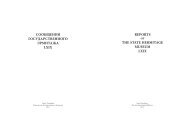The STaTe hermiTage muSeum annual reporT
The STaTe hermiTage muSeum annual reporT
The STaTe hermiTage muSeum annual reporT
Create successful ePaper yourself
Turn your PDF publications into a flip-book with our unique Google optimized e-Paper software.
estoratIon anD conserVatIon restoratIon anD conserVatIon<br />
laBoraTory for ScienTific<br />
reSToraTion of applied arT<br />
oBJecTS<br />
Headed by A. Bantikov<br />
SecTor for reSToraTion<br />
of archaeological meTal<br />
In 2010, 1,500 items were restored in this<br />
sector. A few of the more important and<br />
challenging jobs are described below.<br />
iron helmeT wiTh Silver<br />
decoraTion in relief<br />
Northern Black Sea Area, near Kerch<br />
(ancient Pantikapaion),<br />
first half – middle of the 3rd century B.C.<br />
Restored by N. Yankovskaya<br />
<strong>The</strong> exhibit had already undergone restoration,<br />
with fragments of the helmet walls<br />
pieced together and consolidated with wax<br />
and galipot mastic. An examination of the<br />
items revealed that the back part and neck<br />
flap had disintegrated. In order to exhibit<br />
the helmet, it was necessary to reassemble<br />
all the pieces and to clean the surface of the<br />
silver plates on the cheek guards. In order to<br />
restore the artifact to its original shape and<br />
to reinforce the individual pieces, it had to<br />
be cleaned of old conservation materials:<br />
wax-and-galipot mastic deposits from the<br />
seams and dilapidated conservation varnish<br />
from the surface, which skewed the joining<br />
edges of individual fragments. <strong>The</strong> silver<br />
plates were cleaned and the original shape<br />
reconstructed. <strong>The</strong> conservation made it<br />
possible to consolidate the original materials,<br />
remove the surface stains and recover<br />
the fine details of the silver plate patterning.<br />
Silver rhyTon<br />
Kuban Area, 4th Semibratny Burial Mound,<br />
5th century B.C.<br />
Restored by O. Senatorova<br />
At the start of the restoration process, the<br />
rhyton consisted of two fragments. <strong>The</strong>re<br />
were significant losses and cracks across the<br />
whole surface. <strong>The</strong> metal inside the rhyton<br />
was peeling. <strong>The</strong> butyral film used for backing<br />
in places had disintegrated, causing the<br />
original metal to crack. <strong>The</strong> butyral film and<br />
the old conservation varnish were removed,<br />
the losses and cracks were backed up onto<br />
thin fibreglass cloth and where necessary<br />
supplemented with thin polymer plates following<br />
the original shape.<br />
Iron helmet with silver decoration in relief. Before restoration<br />
Iron helmet with silver decoration in relief. After restoration<br />
Silver rhyton. Fragment. Before restoration Silver rhyton. Fragment. After restoration<br />
Silver Bowl on Three<br />
Shell-Shaped legS wiTh gilding<br />
along <strong>The</strong> rim<br />
Northern Black Sea Area, the Pantikapaion<br />
necropolis, first half of the 3rd century B.C.<br />
Restored by N. Panchenko<br />
<strong>The</strong> object had undergone restoration in<br />
the 1950s, when the walls were reinforced<br />
with copper wire armouring welded on tin<br />
and backed up on thin fabric.<br />
This hardwiring later caused the thin walls<br />
of the cup to crack and fall through, which<br />
created losses and threatened the integrity<br />
of the whole object. <strong>The</strong> old conservation<br />
materials were partially removed: the silver<br />
and wire were cleaned of tin deposits, and<br />
the conservation varnish was removed from<br />
the surface of the object.<br />
<strong>The</strong> cleaning of the surface uncovered the<br />
gilded rim of the cup, which was cleaned as<br />
well. <strong>The</strong>n the cup was strengthened, partly<br />
backed up on fibreglass cloth, and the fragments<br />
were assembled and glued together.<br />
BronZe Jug<br />
Syria – Iraq, 8th – 9th century<br />
Restored by O. Semenova<br />
<strong>The</strong> jug had never undergone conservation<br />
before. <strong>The</strong> whole object was covered<br />
in thick corrosion and soil deposits, under<br />
which it was possible to see the metal surface.<br />
<strong>The</strong>re was a hole in the bottom of the<br />
jug, which was covered with a fabric stopper<br />
in the Middle Ages. <strong>The</strong> body was decorated<br />
with an inlaid rosette. <strong>The</strong> restorers uncovered<br />
the original surface of the jug, revealing<br />
the ornamental neck and the inlay.<br />
BronZe mirror on a lea<strong>The</strong>r<br />
STrap<br />
Tyva, Chinge-Tei, 7th century B.C.<br />
Restored by M. Borovikova<br />
<strong>The</strong> mirror was brought for conservation<br />
after it was uncovered during excavations.<br />
<strong>The</strong> whole surface of the object was covered<br />
in corrosion and soil deposits, the<br />
mirror edges were uneven. On the reverse<br />
in the centre of the mirror there is a handle<br />
shaped as a goat figure, tightly braided<br />
with a fragile leather strap. <strong>The</strong> restorers<br />
uncovered a paste bead on the strap near<br />
the centre of the mirror. <strong>The</strong> conservation<br />
resulted in the surface of the mirror being<br />
cleaned, the strap reinforced and the white<br />
paste bead cleaned.<br />
Silver bowl on three shell-shaped legs with gilding along the rim. After restoration<br />
Bronze jug. Before restoration<br />
Bronze jug. After restoration<br />
74 75




